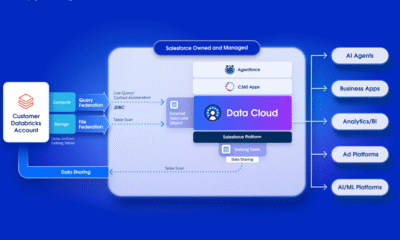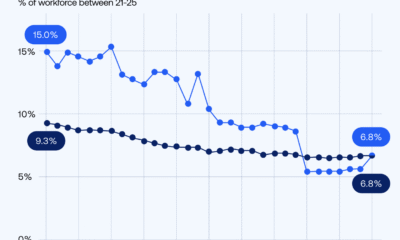Jobs & Careers
SG Teams Up with Salesforce to Digitise India’s Cricket Equipment Industry

Sanspareils Greenlands (SG), a leading Indian cricket and sports equipment manufacturer, announced on September 15 a strategic collaboration with Salesforce to digitise its trade channel sales operations and dealer management system across more than 850 locations in India.
The partnership marks Salesforce’s first collaboration within India’s cricket equipment ecosystem. SG will deploy Salesforce Service Cloud, automation and a unified Dealer Management System to consolidate data, improve dealer interactions and enable real-time insights for decision-making.
“As customer expectations continue to evolve in the sports industry, we believe the future of sports equipment manufacturing lies in data agility, real-time responsiveness, and intelligent decision-making. This collaboration with Salesforce is more than just a technology upgrade; it’s about future-proofing our organisation by embedding intelligence into every dealer interaction and sales touchpoint,” Paras Anand, CEO of Sanspareils Greenlands, said.
“In today’s rapidly evolving industrial landscape, the power of AI is transforming legacy companies like SG at their core. In a country where the passion for cricket runs deep, we are delighted to be a part of this journey, harnessing our AI-powered platform to create new levels of operational efficiency and growth,” Aditi Sharma, regional vice president for sales, Salesforce India, said.
According to the companies, the unified Salesforce platform will automate workflows, improve field productivity, streamline customer support and strengthen partner relationships. SG’s product portfolio includes cricket bats, protective gear, footwear and sportswear, which will all be integrated into the digitised dealer network.
Salesforce added that the collaboration will also support SG’s market expansion plans through AI-driven insights. The company is further advancing its enterprise AI portfolio with Agentforce, a platform designed to build and deploy AI agents capable of autonomously taking action across business functions.
Jobs & Careers
How to Build Production-Ready UI Prototypes in Minutes Using Google Stitch

 Image by Author | Canva
Image by Author | Canva# Introduction
What usually happens during app development is that you and your team finalize a design, go through development and testing, and when it’s finally time to review what you’ve been building for weeks, it just feels off. It either looks underdeveloped or simply “not right.” Too many iterations, too much time, and somewhere along the way, the original idea gets lost.
To solve this, Google introduced a new tool called Google Stitch. You just give simple English commands and get a beautiful, responsive, production-ready prototype you can deploy. And the best part? It’s free to try at stitch.withgoogle.com. In this article, I’ll walk you through my experience using Google Stitch and teach you how to get started too.
# Getting Started with Google Stitch
Head over to stitch.withgoogle.com and sign in with your Google account before starting.
// 1. Choose Your Mode
From the top-right corner of the screen, you can switch between the following modes:
- Standard Mode (Gemini 2.5 Flash): Best for quick drafts and MVPs.
- Experimental Mode (Gemini 2.5 Pro): Lets you generate UI from image inputs, wireframes, or sketches that you can upload for inspiration.
// 2. Describe or Upload
You’ll see a prompt box with a canvas next to it.
- Text prompt example: “A signup form page with logo at top, email/password fields, submit button in primary color.”
- Image prompt (Experimental): Upload a wireframe or screenshot to guide the generation alongside your text.
For instance, I used Standard Mode and gave the following prompt:
“Quiz page in a language learning app with a progress bar at the top. The title challenges you to match an Urdu word with the correct answer, offering four possible options.”
It generated an amazing UI based on this:


// 3. Preview and Tweak
Use the sidebar to adjust themes: change color palettes, fonts, border radius, and switch between dark and light mode. Google Stitch also lets you modify designs using updated prompts.
For example, I updated the theme to dark and changed the font to Manrope. After clicking Apply Theme, the output looked even more polished:


// 4. Iterate Smartly
You can refine individual components or screens. For example:
- “Make the primary button bigger and blue.”
- “Add a navigation bar to the top of the homepage.”
Stitch follows your step-by-step instructions very accurately. In my case, the Urdu words initially appeared as romanized text. So I updated the prompt:
“Display the Urdu word in a right-to-left direction with a large Nastaliq-style font, centered on the screen.”
The result was genuinely impressive:


// 5. Export and Build
You can click on the generated image to copy the code, or hit Paste to Figma to drop editable, auto-layout artboards directly into your design workspace.
Here’s what showed up when I clicked on the image and selected Copy Code. It was instantly ready to integrate into a dev environment or a design file.


# Final Thoughts and Getting the Best Results
Although it’s not a complete design solution, Google Stitch is highly recommended for MVPs and early-stage development. You can always export to Figma for advanced design customization or to build multi-screen logic.
Here are a few tips for getting better results:
- Use UI-specific language like “navbar,” “dashboard widgets,” “primary button,” or “auto-spacing” to guide the structure more accurately.
- Start with a high-level description and refine it step-by-step. For example: “fitness tracking app.”
- Be very specific when editing. Mention elements clearly, such as “change the color of the primary button on the signup form to white.”
Google Stitch is fast, intuitive, and gives you a great starting point when you need working prototypes without getting stuck in weeks of back-and-forth. Definitely worth trying.
Kanwal Mehreen is a machine learning engineer and a technical writer with a profound passion for data science and the intersection of AI with medicine. She co-authored the ebook “Maximizing Productivity with ChatGPT”. As a Google Generation Scholar 2022 for APAC, she champions diversity and academic excellence. She’s also recognized as a Teradata Diversity in Tech Scholar, Mitacs Globalink Research Scholar, and Harvard WeCode Scholar. Kanwal is an ardent advocate for change, having founded FEMCodes to empower women in STEM fields.
Jobs & Careers
7 Free Web Search APIs for AI Agents


Image by Editor | ChatGPT
# Introduction
AI agents are only as effective as their access to fresh, reliable information. Behind the scenes, many agents use web search tools to pull the latest context and ensure their outputs remain relevant. However, not all search APIs are created equal, and not every option will fit seamlessly into your stack or workflow.
In this article, we review the top 7 web search APIs that you can integrate into your agent workflows. For each API, you will find example Python code to help you get started quickly. Best of all, every API we cover offers a free (though limited) tier, allowing you to experiment without needing to enter a credit card or encounter additional hurdles.
1. Firecrawl
Firecrawl provides a dedicated Search API built “for AI,” alongside its crawl/scrape stack. You can choose your output format: clean Markdown, raw HTML, link lists, or screenshots, so the data fits your downstream workflow. It also supports customizable search parameters (e.g. language and country) to target results by locale, and is built for AI agents that need web data at scale.
Installation: pip install firecrawl-py
from firecrawl import Firecrawl
firecrawl = Firecrawl(api_key="fc-YOUR-API-KEY")
results = firecrawl.search(
query="KDnuggets",
limit=3,
)
print(results)
2. Tavily
Tavily is a search engine for AI agents and LLMs that turns queries into vetted, LLM-ready insights in a single API call. Instead of returning raw links and noisy snippets, Tavily aggregates up to 20 sources, then uses proprietary AI to score, filter, and rank the most relevant content for your task, reducing the need for custom scraping and post-processing.
Installation: pip install tavily-python
from tavily import TavilyClient
tavily_client = TavilyClient(api_key="tvly-YOUR_API_KEY")
response = tavily_client.search("Who is MLK?")
print(response)
3. Exa
Exa is an innovative, AI-native search engine that offers four modes: Auto, Fast, Keyword, and Neural. These modes effectively balance precision, speed, and semantic understanding. Built on its own high-quality web index, Exa uses embeddings-powered “next-link prediction” in its Neural search. This feature surfaces links based on meaning rather than exact words, making it particularly effective for exploratory queries and complex, layered filters.
Installation: pip install exa_py
from exa_py import Exa
import os
exa = Exa(os.getenv('EXA_API_KEY'))
result = exa.search(
"hottest AI medical startups",
num_results=2
)
4. Serper.dev
Serper is a fast and cost-effective Google SERP (Search Engine Results Page) API that delivers results in just 1 to 2 seconds. It supports all major Google verticals in one API, including Search, Images, News, Maps, Places, Videos, Shopping, Scholar, Patents, and Autocomplete. It provides structured SERP data, enabling you to build real-time search features without the need for scraping. Serper lets you get started instantly with 2,500 free search queries, no credit card required.
Installation: pip install --upgrade --quiet langchain-community langchain-openai
import os
import pprint
os.environ["SERPER_API_KEY"] = "your-serper-api-key"
from langchain_community.utilities import GoogleSerperAPIWrapper
search = GoogleSerperAPIWrapper()
search.run("Top 5 programming languages in 2025")
5. SerpAPI
SerpApi offers a powerful Google Search API, along with support for additional search engines, delivering structured Search Engine Results Page data. It features robust infrastructure, including global IPs, a complete browser cluster, and CAPTCHA solving to ensure reliable and accurate results. Additionally, SerpApi provides advanced parameters, such as precise location controls through the location parameter and a /locations.json helper.
Installation: pip install google-search-results
from serpapi import GoogleSearch
params = {
"engine": "google_news", # use Google News engine
"q": "Artificial Intelligence", # search query
"hl": "en", # language
"gl": "us", # country
"api_key": "secret_api_key" # replace with your SerpAPI key
}
search = GoogleSearch(params)
results = search.get_dict()
# Print top 5 news results with title + link
for idx, article in enumerate(results.get("news_results", []), start=1):
print(f"{idx}. {article['title']} - {article['link']}")
6. SearchApi
SearchApi offers real-time SERP scraping across many engines and verticals, exposing Google Web along with specialized endpoints such as Google News, Scholar, Autocomplete, Lens, Finance, Patents, Jobs, and Events, plus non-Google sources like Amazon, Bing, Baidu, and Google Play; this breadth lets agents target the right vertical while keeping a single JSON schema and consistent integration path.
import requests
url = "https://www.searchapi.io/api/v1/search"
params = {
"engine": "google_maps",
"q": "best sushi restaurants in New York"
}
response = requests.get(url, params=params)
print(response.text)
7. Brave Search
Brave Search offers a privacy-first API on an independent web index, with endpoints for web, news, and images that work well for grounding LLMs without user tracking. It’s developer-friendly, performant, and includes a free usage plan.
import requests
url = "https://api.search.brave.com/res/v1/web/search"
headers = {
"Accept": "application/json",
"Accept-Encoding": "gzip",
"X-Subscription-Token": ""
}
params = {
"q": "greek restaurants in san francisco"
}
response = requests.get(url, headers=headers, params=params)
if response.status_code == 200:
data = response.json()
print(data)
else:
print(f"Error {response.status_code}: {response.text}")
Wrapping Up
I pair search APIs with Cursor IDE through MCP Search to pull fresh documentation right inside my editor, which speeds up debugging and improves my programming flow. These tools power real-time web applications, agentic RAG workflows, and more, while keeping outputs grounded and reducing hallucinations in sensitive scenarios.
Key advantages:
- Customization for precise queries, including filters, freshness windows, region, and language
- Flexible output formats like JSON, Markdown, or plaintext for seamless agent handoffs
- The option to search and scrape the web to enrich context for your AI agents
- Free tiers and affordable usage-based pricing so you can experiment and scale without worry
Pick the API that matches your stack, latency needs, content coverage, and budget. If you need a place to start, I highly recommend Firecrawl and Tavily. I use both almost every day.
Abid Ali Awan (@1abidaliawan) is a certified data scientist professional who loves building machine learning models. Currently, he is focusing on content creation and writing technical blogs on machine learning and data science technologies. Abid holds a Master’s degree in technology management and a bachelor’s degree in telecommunication engineering. His vision is to build an AI product using a graph neural network for students struggling with mental illness.
Jobs & Careers
Chennai’s OrbitAID Opens Bengaluru Facility for On-Orbit Refuelling, Satellite Servicing

Chennai-based OrbitAID Aerospace has inaugurated a 6,500 square feet research and development facility in Bengaluru to strengthen India’s space capabilities in on-orbit refuelling and satellite servicing. The launch event took place in the presence of Indian Space Research Organisation (ISRO) chairman V Narayanan.
The new centre will support India’s upcoming missions by extending satellite life, reducing space debris and enabling sustainable space operations. Speaking at the event, Narayanan said the facility marks “a monumental milestone in our mission to revolutionise on-orbit refuelling and satellite servicing”.
This development comes just after the startup raised $1.5 million in January this year. This was during a pre-seed funding round led by Unicorn India Ventures, with additional participation from the Tamil Nadu Startup and Innovation Mission (StartupTN).
The funds were to be used to scale the company’s patented Standard Interface Docking and Refuelling Port for commercial use.
Advanced Testbeds & Labs
The R&D facility houses a dedicated Rendezvous Proximity Operations and Docking testbed for autonomous manoeuvre validation, an advanced fuel transfer laboratory for leak-proof propellant technology and a cleanroom for precise satellite assembly and testing.
OrbitAID stated in a LinkedIn post that the in-house infrastructure will accelerate its mission timelines and support India’s transition towards a circular space economy. CEO Sakthikumar R described the opening as a step forward in developing critical technologies such as docking, refuelling and space robotics.
The ceremony brought together senior officials and international delegates, including Lt Gen AK Bhatt (retd), director general of the Indian Space Association (ISpA), who emphasised the importance of “building synergy through public–private partnerships”.
He also highlighted the need to strengthen indigenous technologies to foster self-reliance in the space sector. Consuls general from Germany, Italy and Switzerland and representatives from StartupTN, ISRO and foreign trade bodies also attended.
ISpA congratulated OrbitAID, noting in a LinkedIn post that the facility is “an important step in advancing India’s capabilities in sustainable space operations”.
Sudheer Kumar N, former director of capacity building and public outreach at ISRO, also added, “These technologies are very critical for the upcoming space missions of sustainability, Bharatiya Antariksh Station and debris removal.”
-

 Business3 weeks ago
Business3 weeks agoThe Guardian view on Trump and the Fed: independence is no substitute for accountability | Editorial
-
Tools & Platforms1 month ago
Building Trust in Military AI Starts with Opening the Black Box – War on the Rocks
-

 Ethics & Policy2 months ago
Ethics & Policy2 months agoSDAIA Supports Saudi Arabia’s Leadership in Shaping Global AI Ethics, Policy, and Research – وكالة الأنباء السعودية
-

 Events & Conferences4 months ago
Events & Conferences4 months agoJourney to 1000 models: Scaling Instagram’s recommendation system
-

 Jobs & Careers3 months ago
Jobs & Careers3 months agoMumbai-based Perplexity Alternative Has 60k+ Users Without Funding
-

 Podcasts & Talks2 months ago
Podcasts & Talks2 months agoHappy 4th of July! 🎆 Made with Veo 3 in Gemini
-

 Education3 months ago
Education3 months agoVEX Robotics launches AI-powered classroom robotics system
-

 Education2 months ago
Education2 months agoMacron says UK and France have duty to tackle illegal migration ‘with humanity, solidarity and firmness’ – UK politics live | Politics
-

 Podcasts & Talks2 months ago
Podcasts & Talks2 months agoOpenAI 🤝 @teamganassi
-

 Funding & Business3 months ago
Funding & Business3 months agoKayak and Expedia race to build AI travel agents that turn social posts into itineraries











